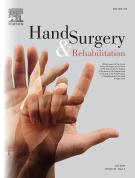Reconstruction of the ulnar artery in Guyon’s canal with an arterial graft: Anatomical study - 19/11/23
 , Colin Piessat a, Manuela Perez b, Pedro Augusto Gondim Teixeira c, François Dap a, Lionel Athlani a
, Colin Piessat a, Manuela Perez b, Pedro Augusto Gondim Teixeira c, François Dap a, Lionel Athlani aCet article a été publié dans un numéro de la revue, cliquez ici pour y accéder
Abstract |
Ulnar artery thrombosis in Guyon’s canal can lead to vascular insufficiency in the fingers. The recommended treatment is resection and reconstruction of the pathological area. A bypass may be necessary, which may be venous or arterial. Arterial bypasses have better long-term patency; however, they are a source of donor-site complications.
We carried out an anatomical study on 11 upper limbs and 7 lower limbs from cadavers to identify a technically accessible arterial graft, of a diameter suitable for bypassing the ulnar artery in Guyon’s canal and with acceptable scar sequelae (few predicted postoperative complications, discreet size and/or location of scar).
Three grafts were considered: anterior interosseous artery, radial recurrent artery and descending genicular artery. The various grafts were dissected and harvested from cadaver specimens, then their lengths and diameters were measured. The diameter of the candidate grafts was compared to the diameter of the distal ulnar artery.
The diameter of the descending genicular artery matched the ulnar artery better than the radial recurrent artery or the anterior interosseous artery (103% vs 44% and 67%, respectively). Mean graft length was 6.6 cm. The anatomical configuration of the descending genicular artery allowed Y-shaped bypasses to be performed. Harvesting this artery appears to cause little damage and allows bypasses up to 6 cm to be performed.
Despite its smaller diameter making it necessary to perform a microvascular size adjustment, the anterior interosseous artery is a candidate graft because it is long enough (119 mm) and located near the surgical site.
Level of evidence |
V.
Le texte complet de cet article est disponible en PDF.Keywords : Ulnar artery, Hypothenar hammer syndrome, Arterial bypass, Cadaveric study, Size mismatch
Plan
Bienvenue sur EM-consulte, la référence des professionnels de santé.
L’accès au texte intégral de cet article nécessite un abonnement.
Déjà abonné à cette revue ?

